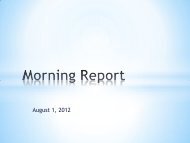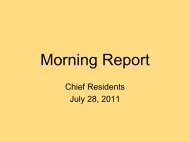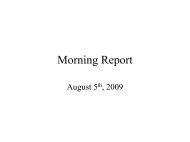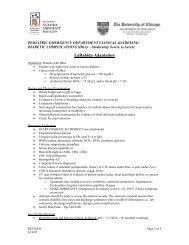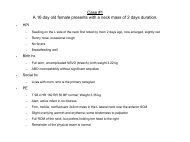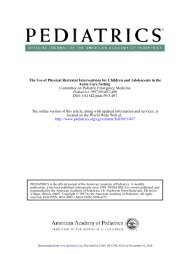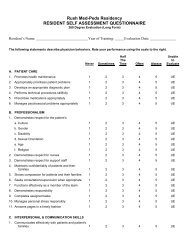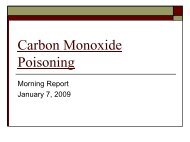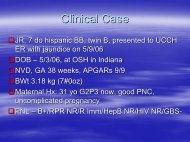15 Spinal dysraphism
15 Spinal dysraphism
15 Spinal dysraphism
You also want an ePaper? Increase the reach of your titles
YUMPU automatically turns print PDFs into web optimized ePapers that Google loves.
March 13 th 2012
• 4 y F comes in FFHC for well child exam<br />
• As you are about to leave mom states…she has been<br />
complaining of leg pain”
• Vitals: 36.5, 100, 24, 90/64,<br />
• Growth Parameters: Wt <strong>15</strong>.2 kg (25%) Ht: 40 in (25%)<br />
• Gen: alert cooperative, smiling<br />
• HEENT: NCAT, PERRL, TM’s clear, neck no LAD, full ROM<br />
• CV: RRR, no murmurs, 2+ femoral pulses<br />
• Pulm: CTA B<br />
• Abdomen: soft NDNT, no masses, no hepatosplenomegaly<br />
• Skin: mild eczematous lesions elbow, knees, sacral dimple<br />
noted as well, no palpable lymph nodes inguinal/axillary<br />
• Extremities: symmetric muscle bulk, no joint swelling, no<br />
palpable point tenderness, full ROM in all joints,<br />
• Neuro: no focal deficits, 5/5 strength, 2+ dtrs, nl gait
• Any thoughts?<br />
• What are you going to tell this mom?
• Which ones are benign?<br />
• When should you be concerned?<br />
• What can they be associated with?<br />
• Which ones should be evaluated further?<br />
• What further evaluation would you do?
Adapted from Pediatrics in Review
Adapted from Pediatrics in Review<br />
• Solitary<br />
• gluteal cleft<br />
• Sacrococcygeal<br />
• Visualized base<br />
• < 2.5 cm from anus<br />
• No other skin<br />
findings
Adapted from Pediatrics in Review
Adapted from Pediatrics in Review<br />
Greater than<br />
2.5 cm from<br />
anus
Adapted from Pediatrics in Review
Appendage<br />
Adapted from Pediatrics in Review
Adapted from Pediatrics in Review
Duplicated<br />
gluteal<br />
cleft<br />
Adapted from Pediatrics in Review
Adapted from Pediatrics in Review
Base visualized<br />
Within 2.5 cm of<br />
anal verge<br />
Adapted from Pediatrics in Review
Adapted from Pediatrics in Review
Atretic<br />
Meningocele<br />
“cigarette<br />
burn”<br />
Adapted from Pediatrics in Review
Adapted from Pediatrics in Review
Hairy tuft<br />
Adapted from Pediatrics in Review
Adapted from Pediatrics in Review
Eccentric/Not Midline<br />
Isolated<br />
Within sacral spine<br />
Abnormal if:<br />
**any other lesions<br />
**outside of sacrum<br />
Adapted from Pediatrics in Review
• Multiple dimples (look up the spine)<br />
• Dimple diameter >5 mm<br />
• Greater than 2.5 cm above anal verge<br />
• Cutaneous stigmata<br />
• Hair tufts, hemangioma, appendages, hyper/hypo-pigmentation<br />
• Gluteal Cleft abnormalities<br />
• Any midline skin lesions or more than one skin marking<br />
anywhere along the spine
• Occultus…<br />
• …clandestine, hidden, secret,<br />
referring to "knowledge of the<br />
hidden<br />
http://audubonoffloridanews.org/?p=3409
1 in 4,000<br />
Skin Covered NTD<br />
90% cutaneous stigmata<br />
Not Spina Bifida Occulta<br />
s<br />
Tethered<br />
Cord<br />
Lipomeningocele<br />
http://www.neurosurgery.ufl.edu/patient<br />
s/pediatric-spina-bifida.shtml<br />
Dermal<br />
Sinus<br />
Tract<br />
Diastematomelia
• 5 y/o F with bilateral leg pain occuring intermittently for the<br />
last few months, that is occasionally waking her up from sleep,<br />
exam wnl with the exception of a sacral dimple
Adapted from Pediatrics in Review
What type of imaging is best?
Ultrasound: infants up to 3-5 mos of age, dynamic<br />
image, no radiation or sedation<br />
Cons: difficult to interpret, operator dependent, hard to<br />
determine if have a fatty filum<br />
MRI: modality of choice for visualizing level of the<br />
conus medullaris and for identifying fatty filum<br />
◦Cons: it may require sedation
L1<br />
S1<br />
Conus low<br />
at mid L2
<strong>Spinal</strong> cord does not<br />
move anteriorly<br />
PRONE
Fatty Filum
• IMPRESSION:<br />
1. Tethered cord with lower than normal position at the level of<br />
mid L2 with diffuse<br />
linear fatty infiltration of the filum terminale<br />
•<br />
2. No evidence of bone deformation of the posterior elements<br />
of the lumbar or sacral<br />
vertebral bodies
What causes it?<br />
What are the symptoms?
True incidence unknown<br />
2:1 (female: male) predominance<br />
May have associated orthopedic/vertebral abnormalities,<br />
anorectal, or urogenital malformations<br />
genetic predisposition?<br />
MRI: Conus medullaris below L2 and a funky filum
• 1° Abnormal embryologic development<br />
• Loss of function of the filum terminalis (elastic band)<br />
• Fatty infiltration /Thickened<br />
• Cord becomes anchored<br />
• stress (esp. flexion/extension)<br />
• ↑stretch<br />
• ↓blood flow/oxidative metabolism<br />
• Neurological signs and symptoms<br />
http://yoursurgery.com/ProcedureDetails.cfm<br />
BR=2&Proc=82
• Pain<br />
• Bladder/Bowel<br />
Function<br />
• Cutaneous<br />
Findings 70-90%<br />
• Delayed<br />
development<br />
• Asymmetry<br />
• Sensorimotor<br />
• LMN signs
• Ultrasound/MRI:<br />
• all abnormal US should have MRI done and neurosurgery<br />
referral.<br />
• Neurosurgery Referral<br />
• Urodynamic Studies<br />
• Can identify deficiencies and also be used as a maker for<br />
improvement
Surgery: un-tethering<br />
Indications:<br />
◦ Symptomatic, low lying conus, abnl filum<br />
◦ Asymptomatic, low lying conus, abnl filum<br />
Complications:<br />
◦ Infection<br />
◦ CSF leakage<br />
◦ Meningitis<br />
◦ Neurologic Damage (
Maximal improvement:<br />
Usually by 6 months<br />
Improvement rates<br />
◦ Pain 90-100%<br />
◦ Sensorimotor 43% (related to duration)<br />
◦ Urodynamics improved 50-87%<br />
Complete urological recovery is rare<br />
Importance of finding these patients before symptomatic!
• Referred to Neurosurgery<br />
• Urodynamic Studies: abnl for low capacity, high pressure<br />
bladder felt to be related to the tethered cord<br />
• VCUG and Renal US normal<br />
• Surgery was performed 2 months after initial MRI<br />
• Currently doing well should be following up soon
• DDx for child with leg pain<br />
• Cutaneous stigmata associated with OSD<br />
• What type of imaging should be done to evaluate these lesions<br />
• Reasons to refer to Neurosurgery<br />
• What are the signs and symptoms of a tethered cord<br />
• ALWAYS CHECK YOUR NEW PATIENTS SPINE/SACRUM!!
Zywicke, Holly MD and Curtis Rozzelle MD. “Sacral Dimples.”<br />
Pediatrics in Review 32 No. 3 (2011):109-113<br />
Bui, Cuong MD; Tubbs, Shane Ph.D.; and Jerry Oakes MD. “Tethered<br />
Cord Syndrome in children a review.” Neurosurg Focus 23(2) (2007)<br />
: E2 p1-9<br />
Tse, Shirley and Ronald M. Laxer. “Approach to Acute Limb Pain in<br />
Childhood” Pediatr. Rev. (2006):27;170-180<br />
Kliegman et al. Nelson Textbook of Pediatrics. Philadelphia:<br />
Saunders, 2007.<br />
Your surgery.com.2007. Laminectomy for Tethered Cord. 6 Mar<br />
2011.<br />



